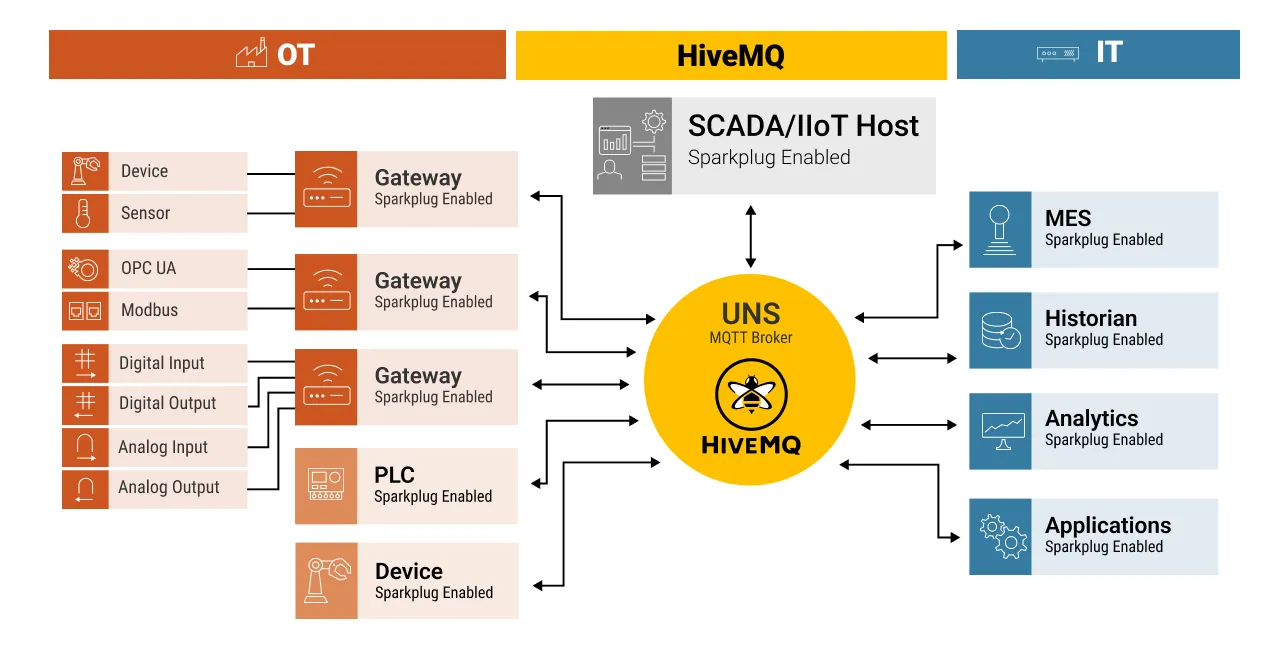11 Ways MQTT Sparkplug Enables Smart Manufacturing
Every deployment of a Historian, MES, ERP system, or similar system can be tied to a manufacturer's decision to increase product quality and yields, improve energy efficiency, improve equipment availability and achieve higher levels of profitability.
This pursuit for operational excellence in manufacturing, primarily driven by the need to meet customer expectations, markedly arose decades ago with the introduction of digital control systems such as Distributed Control Systems (DCS), Supervisory Control and Data Acquisition Systems (SCADA), and Programmable Logic Controllers (PLCs).
Today customers expect higher quality products, consistency in production, improved operating practices, stricter adherence to safety and environmental regulations, and customized products. Therefore, to remain competitive, manufacturers must meet these growing expectations by tapping into process data produced by their legacy manufacturing systems. Doing so, they take advantage of modern advanced analytics systems, significantly improving visibility into process and plant performance.
In addition to increased transparency, manufacturers can further and augment their instrumentation by retrofitting IIoT sensors onto production equipment to monitor their health, maximizing the equipment’s availability for production activities.
In short, manufacturers need to adopt Smart Manufacturing practices. Those who do will have the highest competitive advantage in the market in the coming decades. Manufacturers need a data infrastructure that seamlessly integrates modern tools and unlocks data siloed in legacy automation systems to enable smart manufacturing.
MQTT Sparkplug is a specification that defines how to use MQTT to transport data in real-time from industrial IoT devices and sensors to an MQTT broker. As per the requirements of a Smart Manufacturing data infrastructure, it allows for the seamless and reliable transmission of data from large numbers of devices and sensors, which is essential for enabling real-time monitoring and control of manufacturing processes.
 Sparkplug-based Architecture Bringing Seamless Data Exchange between OT and IT in Smart Manufacturing
Sparkplug-based Architecture Bringing Seamless Data Exchange between OT and IT in Smart Manufacturing
How Does MQTT Sparkplug Enable Smart Manufacturing?
1.Real-time Data Sharing
With MQTT Sparkplug, manufacturers can monitor and control processes, equipment, and products efficiently, as the data exchange between devices and systems happens in real time. Result: Manufacturers can improve efficiency, reduce downtime, and increase product quality.
2. Improved Collaboration
MQTT Sparkplug establishes a single source of truth for data from all siloed OT legacy equipment, enabling and defining it for IT. This supports collaboration and data sharing among different teams and departments, enabling manufacturers to use data across the organization better.
3. Eliminates Custom Programming
MQTT Sparkplug removes the need to program custom scripts to integrate data. Instead, with Sparkplug you can use tools on platforms to configure systems and devices through a graphical interface. This dramatically reduces the risk and life-cycle costs of adding custom software in smart manufacturing ecosystem.
4. Flexible Connectivity
MQTT Sparkplug supports many connectivity options, including wired and wireless networks, allowing manufacturers to connect devices and systems across different locations and environments.
5. Scalability and Reliability
MQTT Sparkplug supports scalable and reliable communication, with built-in mechanisms for handling large volumes of data and ensuring that messages are delivered reliably. This allows manufacturers to support large and complex manufacturing environments without performance degradation or data loss.
6. Improved Security
MQTT Sparkplug supports robust security measures, including encryption, access controls, and user authentication, to protect sensitive data and prevent unauthorized access. For most manufacturers, security and privacy risk is the most significant barrier to adopting smart manufacturing.
7. Improved Data Management
MQTT Sparkplug supports data tagging and metadata, allowing manufacturers to organize, filter, and search data more effectively. This increased data organization enhances data quality and supports advanced analytics and machine learning applications.
8. Simplified Integration
MQTT Sparkplug supports the integration of components by simply plugging them into a common data infrastructure through a single unified interface. This enables a loosely coupled system where elements can be added and removed without affecting how the overall system operates.
9. Original Data Resolution
MQTT Sparkplug’s Report-by-Exception ensures that data is pushed to the MQTT Broker only when it detects a change in the monitored data item. This configuration allows data acquisition to be performed at the original resolution with time relevance so that it can be associated with specific events.
10. Contextualized Data
MQTT Sparkplug contextualizes data by allowing you to add metadata to MQTT messages. This includes characteristics like the data's source and destination and the data's type and format. With this, applications can access the information correctly and use it in the appropriate context.
11. Auto Discovery of Data Producers
In MQTT Sparkplug, devices and applications publish special "announce" messages to the MQTT broker. Other devices and applications connected to the broker can then subscribe to these announcements and use the information they contain to automatically discover and communicate with other instruments and applications on the network.
Bonus Point
Bandwidth Efficient
MQTT Sparkplug is a bandwidth-efficient protocol for Industrial IoT (IIoT) applications. It uses a publish/subscribe messaging model, which allows devices and applications to send and receive messages without needing continuous, dedicated connections. This setup conserves bandwidth, as devices and applications only need to establish connections when they have messages to send or receive. Additionally, MQTT Sparkplug uses binary encoding for its messages, which can be more efficient than text-based encoding schemes.
Conclusion
Overall, MQTT Sparkplug can help manufacturers transition to smart manufacturing by creating more connected, flexible, and responsive manufacturing environments, enabling them to respond to changing market conditions and customer demands more quickly and effectively.
HiveMQ provides the MQTT broker platform required for any Sparkplug architecture. It is 100% compatible with MQTT 3.1.1 & MQTT 5 and helps with easy integration with OT and IT systems with an extension SDK. If you are interested in implementing MQTT Sparkplug in your manufacturing setup, give HiveMQ a try.

Kudzai Manditereza
Kudzai is a tech influencer and electronic engineer based in Germany. As a Sr. Industry Solutions Advocate at HiveMQ, he helps developers and architects adopt MQTT, Unified Namespace (UNS), IIoT solutions, and HiveMQ for their IIoT projects. Kudzai runs a popular YouTube channel focused on IIoT and Smart Manufacturing technologies and he has been recognized as one of the Top 100 global influencers talking about Industry 4.0 online.
